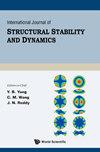60N型道岔影响及优化方法的理论与实验研究
IF 3.4
3区 工程技术
Q2 ENGINEERING, CIVIL
International Journal of Structural Stability and Dynamics
Pub Date : 2023-10-14
DOI:10.1142/s0219455424501475
引用次数: 0
摘要
本研究阐明了60N钢轨廓形对轮轨动力相互作用以及道岔内动力性能的影响。考察了60N型线对投票站长期服务效率的影响。在此基础上,提出了60-60N钢轨组合型线的优化方法。主要结论如下:(1)在主方向上,60N型轨提高了行驶稳定性,减缓了磨损的进展。然而,它会导致钢轨头部的轮轨集中接触,并增加接触应力。(2)在分支方向通过过程中,60N钢轨轮廓放大了封闭面板内的横向动动力和钢轨磨损率,产生两点接触,接触应力增大。(3)在道岔现场服务初期,接触带与轨廓线之间存在较强的相关性。在点轨脆弱截面中,60N轨型道岔接触带完全占据轨头,有可能在非工作边位置造成应力集中。在稳定服役期内,轮轨接触带主要受总重的影响。(4)提出了60-60N组合齿形的优化方法,并设计了相应的刀具齿形。该策略可以避免道岔前后的剖面转变,减少现场维护工作量,提高道岔直通运行稳定性,防止点轨薄弱截面的疲劳损伤。本文章由计算机程序翻译,如有差异,请以英文原文为准。
Theoretical and Experimental Research on the Influence and Optimization Method of the 60N Profile in Turnout
This research elucidates the influence of the 60N rail profile on the dynamic interaction between wheel and rail, and the dynamic performance within the turnout. The influence of the 60N profile on the long-term service efficiency of turnouts was scrutinized. Subsequently, an optimization approach for the 60–60N rail combination profile was suggested. The main conclusions are as follows: (1) During the passage in the main direction, the 60N rail profile enhances driving stability and mitigates the progression of wear. However, it causes focalized wheel–rail contact on the rail head and escalates contact stress. (2) During the passage in the branch direction, the 60N rail profile amplifies the lateral dynamic force and rail wear rate in the closure panel, engendering two-point contact and increased contact stress. (3) In the early stage of field service of turnouts, a robust correlation exists between the contact band and the rail profile. In the fragile cross-section of the point rail, the contact band of the 60N rail profile turnout fully occupies the rail head, potentially causing stress concentration on the non-working edge position. By the stable service period, the wheel–rail contact band is mainly influenced by total weight. (4) An optimization method for the 60–60N combination profile was proposed with the corresponding machining tool profile designed. This strategy can avoid the profile transition before and after the turnout, reduce field maintenance workload, enhance running stability of straight passage through the turnout, and preclude fatigue damage in the weak cross-sections of the point rail.
求助全文
通过发布文献求助,成功后即可免费获取论文全文。
去求助
来源期刊
CiteScore
5.30
自引率
38.90%
发文量
291
审稿时长
4 months
期刊介绍:
The aim of this journal is to provide a unique forum for the publication and rapid dissemination of original research on stability and dynamics of structures. Papers that deal with conventional land-based structures, aerospace structures, marine structures, as well as biostructures and micro- and nano-structures are considered. Papers devoted to all aspects of structural stability and dynamics (both transient and vibration response), ranging from mathematical formulations, novel methods of solutions, to experimental investigations and practical applications in civil, mechanical, aerospace, marine, bio- and nano-engineering will be published.
The important subjects of structural stability and structural dynamics are placed together in this journal because they share somewhat fundamental elements. In recognition of the considerable research interests and recent proliferation of papers in these subjects, it is hoped that the journal may help bring together papers focused on related subjects, including the state-of-the-art surveys, so as to provide a more effective medium for disseminating the latest developments to researchers and engineers.
This journal features a section for technical notes that allows researchers to publish their initial findings or new ideas more speedily. Discussions of papers and concepts will also be published so that researchers can have a vibrant and timely communication with others.

 求助内容:
求助内容: 应助结果提醒方式:
应助结果提醒方式:


